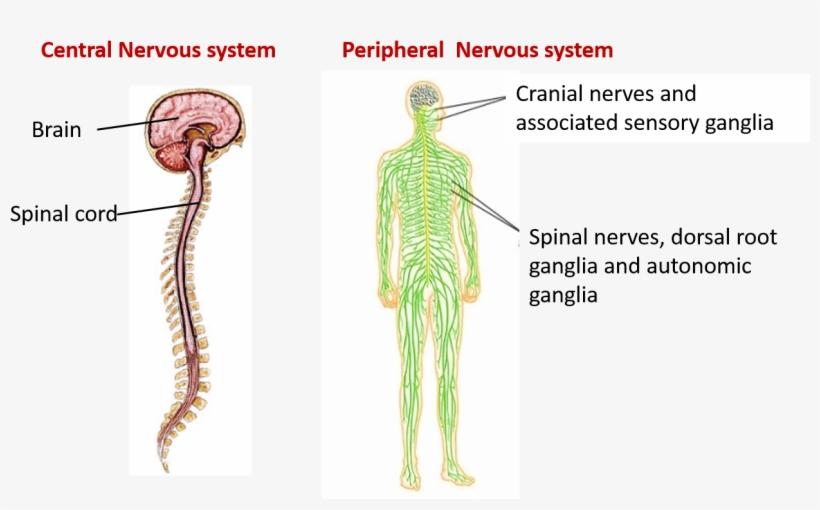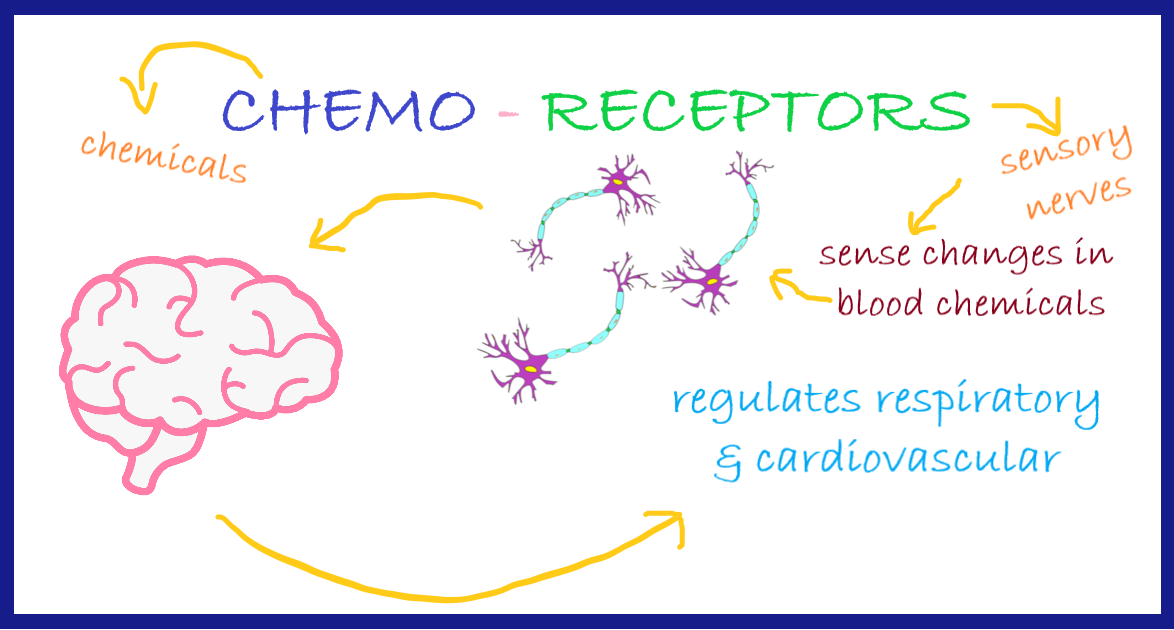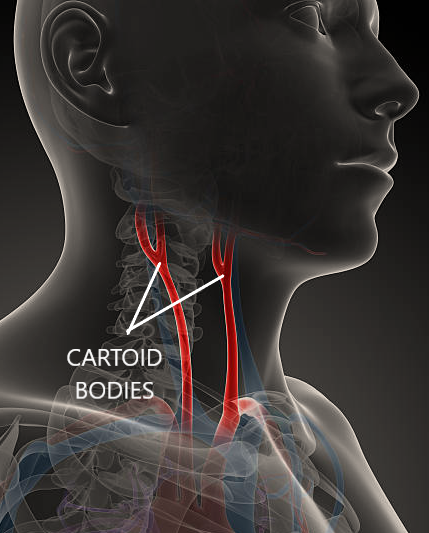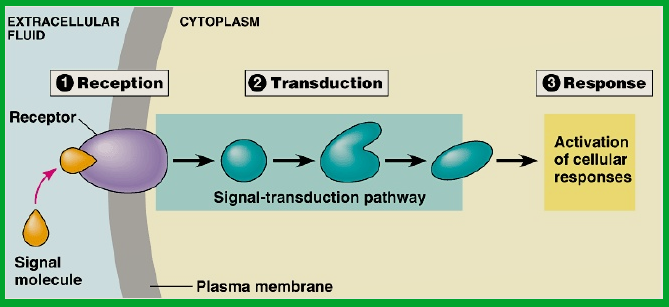What is a Chemoreceptor?
Chemoreceptors are sensory receptors that convert brain chemicals into electrical signals which allow the brain to communicate with the body, more specifically, the respiratory system. They appear in the peripheral and central nervous systems.

What are the Types of Chemoreceptors?
There are central chemoreceptors found in the central nervous system and peripheral chemoreceptors found in the peripheral nervous system. Central chemoreceptors regulate respiration according to chemical changes detected in the brain like differing CO2 and PH levels in the blood.
Whereas peripheral chemoreceptors act quicker because they sense changes in the periphery like air/oxygen pressure. When a partial pressure of oxygen (pO2) is detected by the chemoreceptors, they will communicate with the brain to trigger a biological response such as an increase in respiratory rate, redistribution of blood flow to hypoxia-sensitive organs like the kidneys, and an increase in cardiac output.
A distinction is also made between direct and distance receptors. Distance chemoreceptors lie within the olfactory system. The sense of smell involves chemoreceptors interacting with gasses in the environment and transmitting the information they receive to the brain. On the other hand, direct chemoreceptors lie within the gustatory system and are responsible for our sense of taste. Chemoreceptors in the mouth, such as taste buds, encounter chemical compounds and trigger responses. The responses are either appetitive, encouraging the body to eat, or a defensive response protecting the body from harm.
This video explains central chemoreceptors in more detail:
This video explains peripheral chemoreceptors in more detail:
What is the Role of Chemoreceptors?
Chemoreceptors communicate with the brain to send messages about oxygen levels in the blood and external tastes, smells, and substances which trigger brain reactions like avoiding bad smells and feeling disgusted by them.
More specifically, chemoreceptors interact with the chemicals in things we eat and smell, and the chemicals in our blood. These interactions are communicated with the brain to produce suitable biological impulses.
They have main functions in respiratory regulations and taste/smell sensory reactions.
 One trigger for peripheral chemoreceptors is hypoxia, or reduced oxygen levels in the body due to high altitudes, etc. This stimulates the carotid and aortic bodies to signal to the brain that it needs more oxygen.
One trigger for peripheral chemoreceptors is hypoxia, or reduced oxygen levels in the body due to high altitudes, etc. This stimulates the carotid and aortic bodies to signal to the brain that it needs more oxygen.
Where are the 2 Chemoreceptors?
The 2 types of chemoreceptors are central and peripheral.
Peripheral chemoreceptors are distance receptors. They are found in the neck, more specifically the carotid body and aortic body. These receptors monitor blood chemical levels, notably oxygen and carbon dioxide.
A carotid body is a collection of chemoreceptors and sustentacular cells. The sustentacular cells support olfactory functioning.
There are two carotid bodies found in the neck at the division of each of the carotid arteries.
There are two carotid arteries, which exist on either side of the neck, that supply the brain with blood.

The aortic body is a cluster of nonchromaffin paraganglion cells. This body is found at the base of the heart in the aorticopulmonary area. These cells detect oxygen and carbon dioxide levels, as well as the PH of the blood.

Central chemoreceptors are sensory receptors that process taste and smell by interacting with chemicals in the mouth. These receptors react to changes in partial pressure of CO2 through the cerebral spinal fluid. Central chemoreceptors are found in the medulla oblongata.
Here is a helpful video on the differences between baroreceptors and chemoreceptors:
Respiration, circulation, and metabolism
The respiratory system relies on the interaction between respiration, circulation, and metabolism. The body’s cells need a certain amount of oxygen uptake and carbon dioxide expulsion for gas exchange to occur in the lungs. Therefore, blood must circulate oxygen to the body’s cells to meet their metabolic needs.
Chemoreceptors in Plant Biology
All living things require chemoreceptors to detect food, mates, and even danger. For example, odors or pheromones can help animals detect when predators or prey are nearby. Even plants have chemoreceptors. Plants have surface-level receptor kinases which can detect microbes and pathogens. These receptor kinases are used to grow the plant and induce its hormones by utilizing cell signaling.

Mechanics of Breathing and Heart Rate
Specific chemoreceptors detect blood CO2 levels by observing hydrogen concentrations which lower the blood pH level. Excessive hydrogen ions in the blood can be caused by an increase in CO2 levels because aqueous CO2, ie: carbonic anhydrase, forms bicarbonate ions and protons.
The resulting reaction is nervous impulses are sent from the respiratory center within the medulla to the diaphragm and intercostal muscles. The impulses are sent through the phrenic and intercostal nerves to increase the rate of respiration and lung volume.
Chemoreceptors in the lungs, heart, and nearby arteries can influence heart rate. These peripheral receptors are triggered by increased carbon dioxide, decreased oxygen, and decreased pH levels. The stimulation of the receptors is conveyed to the cardiac centers via the glossopharyngeal and vagus nerves to the medulla.
This process then activates a nervous system response which increases the heart rate and contractility. Including the expulsion of catecholamines and the stimulation of stretch receptors because of increased ventilation.
Recap
Here is a useful video briefly recapping everything you need to know about chemoreceptors:
Bibliography
Resnik, R., Creasy, R. K., Iams J. D., Lockwood, C. J. and Moore, T. R. (2019) ‘Creasy and Resnik’s Maternal-Fetal Medicine: Principles and Practice’. Obstetric Medicine. Vol.5(2). pp.88-89
Hall, J. E (2021) Guyton and Hall Textbook of Medical Physiology. Philadelphia: Saunders Elsevier.
Squire, L., Berg, D., Bloom, F. E., Lac, S., Ghosh, A. and Spitzer, N. C. (2012) Fundamental Neuroscience. Massachusetts: Academic Press.
Squire, L. R. (2009) E Encyclopedia of Neuroscience. Amsterdam: Elsevier.
Sanchis-López, C., Cerns-Vargas, J. P., Santamaría-Hernando, S., Ramos, C., Krell, T., Rodríguez-Palenzuela, P., López-Solanilla, E., Huerta-Cepas, J., and Rodríguez-Herva, J. J. (2021) ‘Prevalence and Specificity of Chemoreceptor Profiles in Plant-Associated Bacteria’. American Society for Microbiology.Vol. 6(5).



